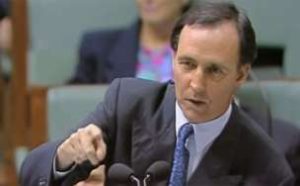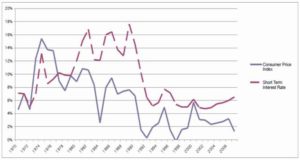Lessons from the recession we didn’t have to have
Warwick Smith

Australia’s last formal recession ended in the September quarter of 1991. Once it sunk in that this was a serious economic downturn, treasurer Paul Keating famously referred to it as “the recession Australia had to have”. This narrative of the recession seemed plausible at the time. A necessary correction for the twin problems of inflation and current account deficits. But it remains a point of contention among political and economic historians and the policy makers involved.
The selected key cabinet papers for 1990 and 1991 released recently by the National Archives of Australia appear to support those who see the recession as likely caused and certainly exacerbated by monetary and fiscal policy. Policy that was overly concerned with the current account deficit. The current account is a measure of trade balance and reflects Australia’s net financial position with the rest of the world. It was a measure of genuine importance to governments during the Bretton-Woods era of set exchange rates and the gold standard, but is considered of little importance today. The 1990-91 cabinet papers confirm the focus given to the current account in both budgetary and micro-economic reform considerations:
“The Committee noted the need to take action to ensure that fiscal policy and the Budget surplus continue to be a key elements [sic] in demand management strategy, thereby helping reduce the current account deficit and dependence on overseas savings.” – First paragraph of the Expenditure Review Committee’s (ERC) 1990 cabinet submission titled Economic and Fiscal Policy Strategy (7055).”
Even in the midst of the economic downturn Keating was keen to defend the surplus as it contributed to national savings and kept downward pressure on inflation and exchange rates. The result was policy carefully aimed at increasing national output while holding down domestic demand, thus hopefully spurring exports and balancing the current account.

The Reserve Bank at the time also had a multi-targeted approach to monetary policy with concern not only for inflation but also current account and exchange rates. This meant monetary policy was tighter in the lead-up to the recession than it would have been if inflation was the principal target – as it is today. You can see from the graph shown above that monetary policy was most conspicuously out of step with inflation in 1989 right before the recession, with a big spike in interest rates despite only a very modest rise in inflation.
Typical of those looking back at their actions during this period, former RBA governor Ian Macfarlane omits mention of the current account in his defence of fiscal policy at the time, even though Reserve Bank documents make it clear this was a major consideration.
The cabinet papers reveal a two- pronged approach to dealing with both inflation and the current account deficit; maintaining tight fiscal policy and keeping a lid on wages.
When it came to fiscal policy, proposals from ministers for new money were sorted by the hard-line Expenditure Review Committee into “unavoidable”, “deferrable” or “dispensable” and only those categorised as unavoidable were considered for inclusion in the 1990-91 budget. Of the 219 policies under consideration, only 51 were determined to be unavoidable, the rest being either deferred (55) or binned altogether (113)
In spite of Bob Hawke’s claims that sustainability and environmental protection were key priorities of his government, basically every item of new expenditure for the environment was labelled dispensable or deferrable. There were ongoing internal divisions over continuing the so-far successful strategy of chasing the “green vote”. Of some contemporary interest is the fact that a request for funding for “Climate change policy – Multifaceted Program Initiatives” was dumped into the “dispensable” category.
This hard-nosed attitude to new spending flew in the face of long-standing orthodoxy supporting Keynesian fiscal stimulus during a downturn. The major justification for this was the state of the current account. Inflation was part of that discussion but it was mentioned less often and given a back seat to the perceived current account problems.
In relation to the second policy focus, that of wage constraint, the cabinet submissions read like a Howard era Liberal party policy. The emphasis was on workforce flexibility, enterprise bargaining, productivity gains and the improvement of Australia’s competitive position; particularly in manufacturing and textiles.
Wage constraint was seen as a critical component of restoring international competitiveness and our current account position. As a result, industrial relations reform tended to shift power towards employers while lauding the unions for taking a hit for the common good.
The collapse of Bretton-Woods and the abandonment of the gold standard in the 1970s meant a new paradigm for both fiscal and monetary policy. But such profound changes generally take a long time to be fully understood by bureaucrats, academics and policy makers alike.
The depth of the 1990-91 recession led to a rethink of monetary and fiscal policy. The Reserve Bank shifted focus to prioritising inflation as a target along with economic growth, abandoning consideration of the current account and the exchange rate.
The recession may not have been inevitable but the resulting plunge in inflation, combined with the new Reserve Bank focus, has created a low and relatively stable level of inflation in Australia ever since. This has certainly been a major contributor to our current record streak of uninterrupted growth.
Governments no longer take much interest in the current account figures. In fact, it’s hard to find somebody who admits that they (personally) ever did. If private individuals and institutions
hold foreign debt it’s considered their own business. We’re yet to encounter a level of current account deficit that is unsustainable or that threatens the national economy (that’s not to say, of course, that such a level doesn’t exist).
While the evidence, with the benefit of hindsight, suggests the recession could have been avoided or ameliorated through looser monetary and fiscal policy, this would have required a level of policy insight that was not available at the time. It was reflection on the recession that created this insight.
To complete the lesson we now need policy makers and academics to understand what the collapse of Bretton-Woods really meant for fiscal policy. In 25 years’ time commentators and historians will almost certainly be looking back on current cabinet papers and similarly shaking their heads at the unnecessary obsession with fiscal deficits and surpluses.
Source: The Conversation, 1 January, 2016 https://theconversation.com/cabinet-papers-1990-lessons-from-the-recession-we-didnt-have-to-have-52153?
 Warwick Smith is a research economist at the University of Melbourne and a freelance writer. His current research is on carbon tax economics and how farmers can make profitable use of carbon pricing, revegetate their land and restore biodiversity. Warwick’s research interests are very broad, including evidence in public policy making, taxation economics and the history and philosophy of economics.
Warwick Smith is a research economist at the University of Melbourne and a freelance writer. His current research is on carbon tax economics and how farmers can make profitable use of carbon pricing, revegetate their land and restore biodiversity. Warwick’s research interests are very broad, including evidence in public policy making, taxation economics and the history and philosophy of economics.



























